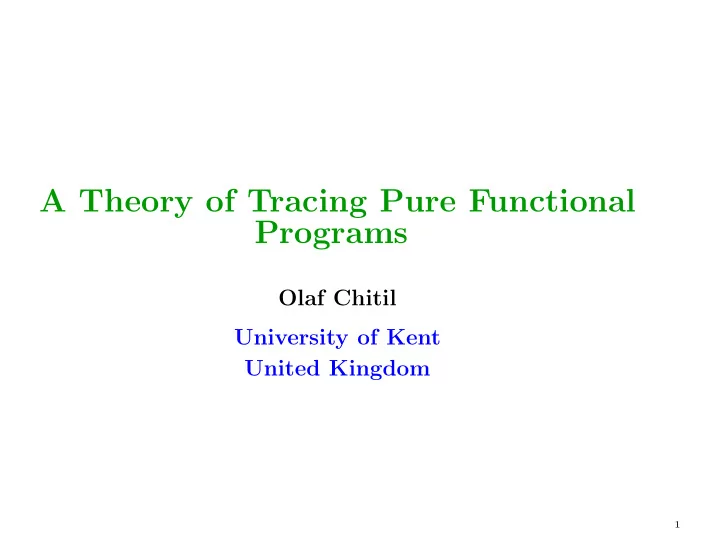

A Theory of Tracing Pure Functional Programs Olaf Chitil University of Kent United Kingdom 1
Tracing a Computation program input computation output Aims: • locate bugs (wrong output, abortion, non-termination) • comprehend programs 2
Conventional Debugging Techniques: • print statements • debuggers such as gdb Show at a point of time in computation a part of computation state. Properties: • expose (abstract) machine • erroneous value often observed long after bug 3
Declarative Languages Abstract machines more complex, should be hidden from programmer. elem :: Int -> [Int] -> Bool elem x xs = or (map (==x) xs) elem 42 [1..] ❀ or (map (== 42) [1..]) ❀ or (map (== 42) (1:[2..])) ❀ or (False : map (== 42) [2..]) ❀ or (map (== 42) [2..]) ❀ . . . Instead take advantage of purity: no side-effect, only result. 4
Algorithmic Debugging sort "sort" = "os" ? n insert :: Ord a => a -> [a] -> [a] insert ’s’ "o" = "os" ? y insert x [] = [x] insert x (y:ys) = sort "ort" = "o" ? n if x > y then y : insert x ys else x : ys insert ’o’ "r" = "o" ? n sort :: Ord a => [a] -> [a] ’o’ <= ’r’ = True ? y sort [] = [] sort (x:xs) = insert x (sort xs) Error located: second equation of ‘insert‘, main = print (sort "sort") taking else branch. Freja by Henrik Nilsson 5
The Evaluation Dependency Tree for Algorithmic Debugging main = "os" × sort "sort" = "os" × insert ’s’ "o" = "os" √ sort "ort" = "o" × ’s’ <= ’o’ = False insert ’s’ "" = "s" insert ’o’ "r" = "o" × sort "rt" = "r" ’o’ <= ’r’ = True √ sort "t" = "t" insert ’r’ "t" = "r" sort "" = "" insert ’t’ "" = "t" ’r’ <= ’t’ = True 6
Source-Based Algorithmic Debugging ==== Hat-Explore 2.00 ==== Call 2/2 ============================= 1. main = { IO } 2. sort "sort" = "os" 3. sort "ort" = "o" ---- Insert.hs ---- lines 5 to 10 ------------------------------- if x > y then y : insert x ys else x : ys sort :: [Char] -> [Char] sort [] = [] sort (x:xs) = insert x ( sort xs ) Hat by Colin Runciman, Malcolm Wallace, Olaf Chitil, ... 7
Observation of Expressions and Functions Observation of function sort: Observation of function insert: sort "sort" = "os" insert ’s’ "o" = "os" sort "ort" = "o" insert ’s’ "" = "s" sort "rt" = "r" insert ’o’ "r" = "o" sort "t" = "t" insert ’r’ "t" = "r" sort "" = "" insert ’t’ "" = "t" Hood by Andy Gill 8
Redex Trails Output: ------------------------------------------------------------ os\n Trail: ------- Insert.hs line: 10 col: 25 -------------------------- <- putStrLn "os" <- insert ’s’ "o" | if True <- insert ’o’ "r" | if False <- insert ’r’ "t" | if False <- insert ’t’ [] <- sort [] Go backwards: which redex created this expression? Original Hat by Colin Runciman and Jan Sparud 9
Implementations Algorithmic Debugging: Freja, Hat, Buddha Observations: Hood, Hugs-Hood, GHood, Hat Redex Trails: Hat • Two phases: trace generation + trace viewing • Trace liberates from time arrow of computation Architecture of Hat: input output hat-explore self-tracing trace hat-observe computation hat-trail 10
Challenges Problems: • (In)correctness of Algorithmic Debugging • What is tracing? Systems disagree • Tracing of all language features • Partial traces Need to generalise: • Tracing eager functional languages • Flexible algorithmic debugging ⊲ factorial (-2) = 42 ? • Multi-level algorithmic debugging • Trace transformation before viewing • Partial Traces 11
Summary • Tracing techniques should take advantage of features of declarative languages. ⊲ Algorithmic Debugging ⊲ Observations ⊲ Redex Trails • Implementations are currently ahead of theoretical results. 12
Recommend
More recommend